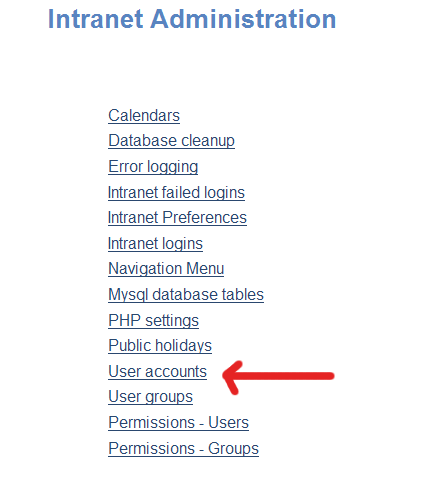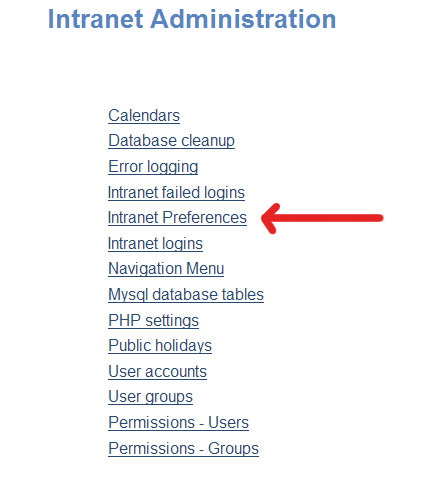
Brushtail MySQL can be upgraded from 3.0/3.1/3.2 to 3.3 using a php script.
Load the upgrade_3-3.3.php script in your web browser, something like http://localhost/intranet/sql/upgrade_3-3.3.php
The upgrade script requires:
Place the intranet files in the webserver document directory. Edit the file
config.php in the includes folder.
Database format (Compulsory)
$DATABASE_FORMAT needs to be set to "mysql" or "sqlite".
MySQL CONNECTIONS SETTINGS
These paremeters must be set for the intranet to coonect to MySQL.
$DBUSER= "usernamet";
$DBPASSWORD = "userpassword";
$DATABASE = "intranet";
$HOST = "localhost";
SQLITE SETTINGS
Enter path to sqlite database file.
$SQLITE = "intranet.db"
LOCALE SETTINGS (optional)
You can also set the language for the calendars so the month and day names
display in the correct language. This example sets it to German.
$locale = setlocale(LC_ALL, 'de_DE@euro', 'de_DE', 'de', 'ge'); //GERMANY
LDAP SETTINGS (optional)
Requires php LDAP support.
LDAP can be used to authenticate users. The LDAPHOST parameter. Indicates the
LDAP or Active directory server. The other LDAP paramters if you want users
to be able update their Windows password via the intranet. For testing LDAP authentication try using the intranet/main/ldaptest.php utility.
$LDAPHOST = "servername";
IMAP settings (optional)
Requires php IMAP support. Used for authenticating users via imap/pop3. Check php website for information on syntax. http://www.php.net/manual/en/function.imap-open.php
$MAILSERVER = "{10.10.10.10:143/imap}";
Intranet PC bookings
$REFRESH = 5;
This parameter indicates the interval in minutes the staff booking screen automatically refreshes.
$PCFOOTER = "
Book a pc online at
www.foo.org/web/pcbookings.php";
PC booking slips footer text.
Online pc bookings
$BOOKINGINTERVAL = 30;
This parameter indicates the interval in minutes used on the list of available booking times.
$DAYSAHEAD = 7;
This is how may days ahead you can book
$DISPLAYPCNAME = 1;
Set to 0 to hide the pc in the booking confirmation.
WEB BOOKINGS - patron authentication (optional)
For a fuller discussion see the web bookings page of the Administrator manual.
$PCAUTHENTICATION = "disabled"; //values: disabled/autoaccept/local/web/ldap/email
$EVENTAUTHENTICATION = "disabled"; //values: disabled/autoaccept/local/web/ldap/email
if authentication is set to catalogue, specify catalogue web form parameters. This allows patrons to make bookings that are authenticated via a library system web catalogue (or any web form!)
$WEBHOST = 'webcatalogue';
$WEBPATH = '/urlpath/';
$STRINGACTION = "accept"; //values: accept/deny
$STRING = "login successfull";
$USERFIELD = "user_id";
$PASSWORDFIELD = "password";
$OTHERFIELDS["example"] = ""; //other hidden form fields can be added using this format
To test these paramteters use the sql/webtest.php utility. This will actually display what is outputted in respnse to the web authentication. This will help you identify the "string" you will be looking for.
Some web catalogues have hidden input fields with temporary dynamic data. To solve this problem,Brushtail can download the opac login page, strip the hidden field values and submit these values with the barcode and PIN.
For eaxmple, if the opac login is http://opacaddress/opacloginpage.htm, then the config parameter would be:
$OTHERFIELDS["formurl"] = "http://opacaddress/opacloginpage.htm";
If the intranet server cannot connect to the web catalogue directly, requiring a web proxy, then the proxy IP address and port number will need to be set with the following parameters:
$PROXY_IP = "";
$PROXY_PORT = "";
Compression
PHP can gzip compress page html output for faster page loading. Not necessary if the web server is already performing compression. Requires zlip compression enabled in PHP. values "on" or "off".
$COMPRESSION = "on";
Delete the sql directory.
Enter the url of the intranet eg http://hostname/intranet/index.php
Log in as user name "administrator" , default password "administrator".
Change the administrator password. the Intranet got to "Intranet Administration
To change the administrator passwordgot to "Intranet Administration", then click on "User accounts" and edit the administrator account.

To configure the Intranet got to "Intranet Administration", then click on "Intranet Preferences"

See the page "Intranet Preferences" of this manual for more details.